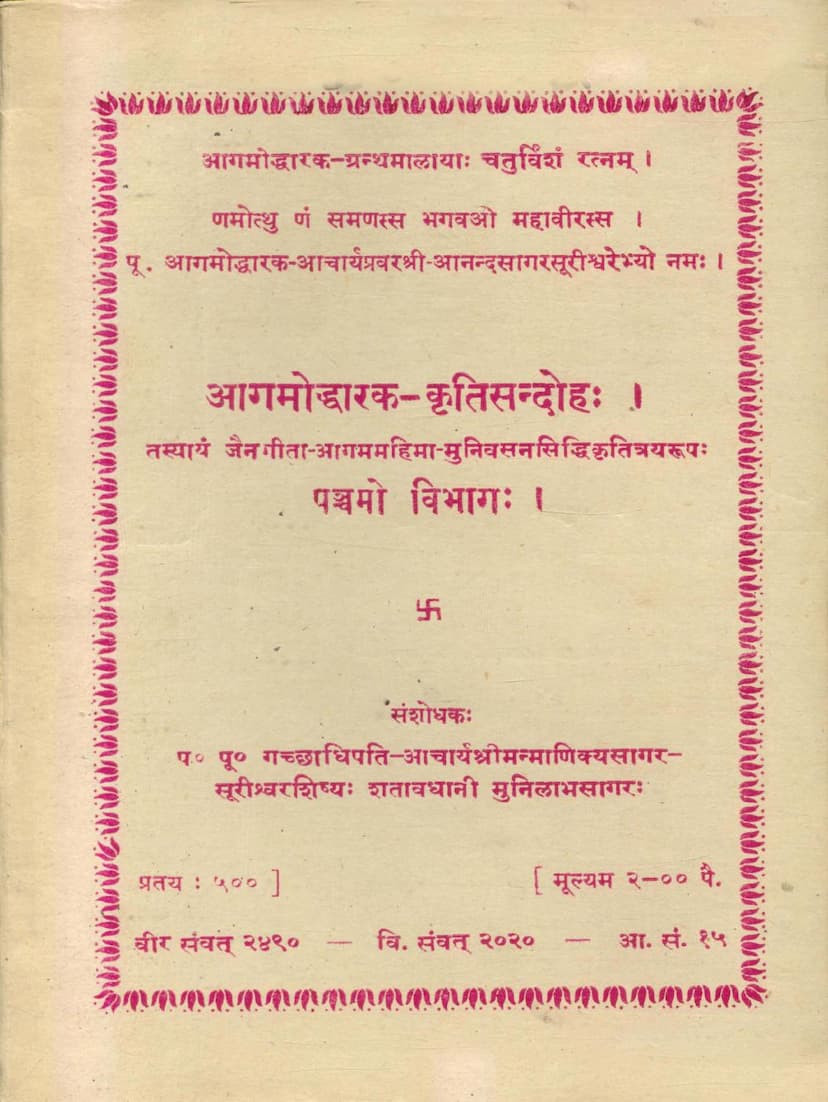Agamoddharak Krutisanodh
Added to library: September 1, 2025

Summary
Here's a comprehensive summary of the Jain text "Agamoddharak Krutisanodh," based on the provided pages:
Overall Purpose and Context:
This text, "Agamoddharak Krutisanodh," is the fifth volume of the "Agamoddharak Granthmala" series, specifically the twenty-fourth jewel in its collection. It is a compilation of three important Jain works: "Jain Gita," "Agam Mahima," and "Munivasan Siddhi." The text is dedicated to the revered Agamoddharak Acharya Shri Anand Sagar Surishwarji. The compiler and researcher is Muni Labhsagar, a disciple of Acharya Shri Manikya Sagar Surishwarji. The publication was supported by the Malegaon Jain Sangh Gyan Khata. The text was published in Veer Samvat 2490 and Vikram Samvat 2020, with an initial print run of 500 copies and a price of ₹2.00.
Key Content and Themes:
The majority of the provided pages (Pages 8-205) are dedicated to the "Jain Gita" (जैनगीता), which appears to be a poetic and philosophical exposition of Jain principles. The work is divided into numerous chapters, each focusing on a specific aspect of Jainism. Based on the chapter titles and initial verses, the "Jain Gita" covers a wide range of topics, including:
- The Nature of the Arhat (Jinas): Chapter 1 ("Arhad Adhikara") describes the qualities and attributes of the Tirthankaras, emphasizing their purity, omniscience, compassion, and role as guides to liberation.
- The State of the Siddhas: Chapter 2 ("Siddha Adhikara") elaborates on the liberated souls (Siddhas) who reside in the highest heavens, possessing perfect knowledge, bliss, and eternal existence. It details the path of karma destruction and spiritual purification leading to this state.
- The Role of Acharyas and Upadhyayas: Chapters 3 and 4 ("Acharya Adhikara," "Upadhyaya Adhikara") highlight the importance of spiritual preceptors (Acharyas) and teachers (Upadhyayas) in guiding the followers of Jainism, preserving and expounding the scriptures.
- The Conduct of Sadhus and Shravakas: Chapters 5 and 11 ("Sadhu Adhikara," "Sravaka Adhikara") discuss the vows and practices of Jain ascetics (Sadhus) and lay followers (Shravakas), emphasizing principles like non-violence, truthfulness, non-stealing, celibacy, and non-possession.
- The Importance of Right Faith (Samyaktva): Chapters 6 and 19 ("Darshan Adhikara," "Ahimsavrata Adhikara") explain the significance of right faith, its constituent elements, and its role in achieving liberation. Ahimsa (non-violence) is presented as a fundamental vow.
- Knowledge and Conduct: Chapters 7 and 8 ("Jnana Adhikara," "Charitra Adhikara") delve into the nature of true knowledge and righteous conduct, emphasizing their interconnectedness and their role in spiritual progress.
- The Significance of Austerities (Tapas): Chapter 9 ("Tapo Adhikara") discusses the various forms of austerities and their importance in purifying the soul and burning away karma.
- The Nature of Soul and Non-Soul: Chapters 10 and 11 ("Jiva Adhikara," "Ajiva Adhikara") explore the Jain metaphysical concepts of soul (Jiva) and non-soul (Ajiva), their characteristics, and their interaction within the universe.
- Merit and Demerit: Chapters 12 and 13 ("Punya Adhikara," "Papa Adhikara") explain the concepts of merit (Punya) and demerit (Papa), their karmic consequences, and the importance of avoiding negative actions.
- The Path of Liberation and Binding: Chapters 14, 15, and 16 ("Ashrava Adhikara," "Samvara Adhikara," "Bandha Adhikara") explain the processes of inflow of karma (Ashrava), cessation of karma (Samvara), and the bondage of karma (Bandha), outlining the means to achieve liberation.
- The Importance of Faith and Principles: The text repeatedly stresses the core Jain principles, often referred to as the "jewels" of Jainism (Samavtar, Samvara, Nirjara, Moksha, right faith, right knowledge, right conduct).
- The Role of Scripture and Tradition: The text emphasizes the authority of the Agamas and the teachings of the Tirthankaras and their successors. The importance of adherence to these teachings is a recurring theme.
- The Concept of Non-Violence (Ahimsa): This is a central theme, discussed in relation to Sadhu conduct, householder vows, and the inherent nature of living beings.
- Ethical Virtues: The text likely covers other virtues like truthfulness (Satya), non-stealing (Asteya), celibacy (Brahmacharya), and non-possession (Aparigraha) as part of the vows for Sadhus and Shravakas.
- The Role of Religious Places and Practices: Chapters on "Jinbimba Adhikara" and "Chaitya Adhikara" discuss the significance of idols, temples, and devotional practices.
- The Nature of Karma: The text likely explains the complex doctrine of karma, its influx, bondage, and eventual destruction.
Specific Works within the Compilation:
- Jain Gita (जैनगीता): This appears to be the main poetic exposition, structured into chapters covering the fundamental principles of Jainism. The verses provide philosophical insights into the path of spiritual liberation.
- Agam Mahima (आगम-महिमा): This section likely focuses on the glory and importance of the Jain Agamas (scriptures). It emphasizes their divine origin, their role in guiding beings towards liberation, and the need to study and follow their teachings.
- Munivasan Siddhi (मुनिवसन-सिद्धि): The meaning of this title is less clear from the given pages but likely relates to the attire of ascetics and the spiritual attainment (Siddhi) associated with their renunciation.
Compilation and Editorial Aspects:
The "Shuddhipatra" (शुद्धिपत्रम्) on page 4 indicates that it is a corrigendum, listing errors and their corrections found during the compilation and printing process. This shows a meticulous approach to presenting the text accurately. The inclusion of a "Vishayanukrama" (विषयानुक्रमः) or subject index on page 6 further aids in navigating the vast content of the work.
Overall Message:
The "Agamoddharak Krutisanodh," through its constituent parts, aims to guide the reader towards a deeper understanding and practice of Jain philosophy and ethics. It emphasizes the path of renunciation, non-violence, self-discipline, and devotion to the Tirthankaras and the Agamas as the means to achieve ultimate liberation (Moksha). The text serves as a comprehensive guide for spiritual aspirants within the Jain tradition.